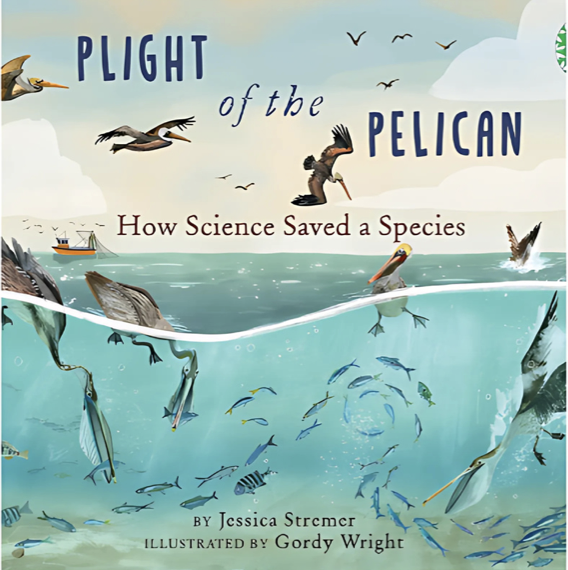
This was a case of being grabbed by a subtitle… “How Science Saved a Species” hooked me, and after reading, I knew this was a book to bring to the attention of 10,000 Bird followers. In her nonfiction picture book Plight of the Pelican: How Science Saved a Species, author Jessica Stremer uses the decline of pelicans to explain how scientists were able to identify and mitigate the impact of pesticides on birds.

Plight of the Pelican is part of publisher Holiday House’s “Books for a Better Earth” collection, which focuses on solutions to climate change challenges, and are designed to inspire young people to become knowledgeable participants in caring for our planet.
As the national bird of the United States, the Bald Eagle is usually held up as the poster child to highlight the impacts of the pesticide DDT. But DDT’s impact wasn’t limited to eagles, and Jessica’s choice to center this book on brown pelicans broadens the story. She follows scientists as they discover weak eggs that cracked under the weight of the parents, the link to DDT, and the work to convince the government to regulate this chemical.
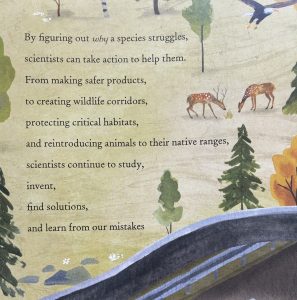
“Be the Change” call to action in Plight of the Pelican by Jessica Stremer, illustrated by Gordy Wright
But scientists alone are not enough, and Plight of the Pelican addresses the importance of people demanding change, using their voices to inspire change.
Scottish illustrator Gordy Wright specializes in nonfiction picture books for children, particularly nature-based books. His bright, sweeping, illustrations take the reader from the pelican’s near extinction to a now-populous species. He uses a brilliant double vertical spread to depict the buildup of DDT, using red dot to depict the chemical in the water, then building through the food web, from plankton to krill to fish to the pelican.
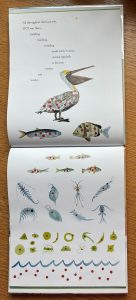
DDT in the food chain in the book Plight of the Pelican by Jessica Stremer, illustrated by Gordy Wright
That is followed by a blue and wordless nighttime spread, where the dots of the DDT in the previous spread are echoed in the lights of ships and the moon with a single, solitary pelican. With those two spreads, Gordy gives the reader an emotional investment in the need to save this species.

Wordless spread in Plight of the Pelican, illustrated by Gordy Wright, of a single pelican at night
Backmatter in Plight of the Pelican includes a glossary, bibliography, further information about brown pelicans, a call to action, and a section on “The Start of a Movement.” I always start nonfiction picture books by reading the backmatter, and this sections on the work to ban DDT is a great place to begin this book before reading it aloud to kids. While scientist Rachel Carson is not called out by name in the text (there are already a number of children’s books about her), her impact is addressed in the backmatter.

“Be the Change” call to action in Plight of the Pelican; written by Jessica Stremer and illustrated by Gordy Wright
I was fascinated to learn that it was nearly a century — 99 years, to be precise — between the creation of the chemical DDT in 1874 and the passage in the United States of the Endangered Species Act (ESA) in 1973. It was the creation of the ESA that finally enabled scientists to work with the government to stop human actions that could further harm at-risk plants and animals.
With its intersection of science and birdlife, this book belongs on all school and library bookshelves, and in home libraries with a love for great, true stories. Jessica’s lyrical writing makes this book perfect both for young readers to read on their own, for read-aloud story times, and in school as in introduction to units on the food web and the interconnectedness of life.
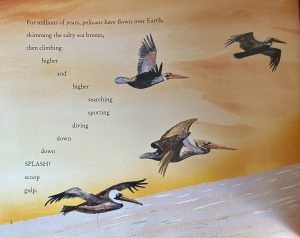
“For millions of year, pelicans have flown over Earth, skimming the sultry sea breeze, then climbing higher and higher searching spotting diving down down SPLASH! scoop gulp.”
Jessica is an award-winning author, with books that inspire kids to explore and think critically about the world around them. This books pairs well with one of her works featured in earlier 10,000 Birds: Lights Out! A Movement to Help Migrating Birds.
******************************************************************************
Plight of the Pelican, written by Jessica Stremer, illustrated by Gordy Wright
Holiday House Publishing, 2025
ISBN: 978-0-6397-8234-5703-8
40 pages, ages 5-8






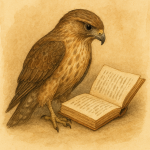
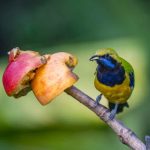
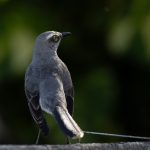


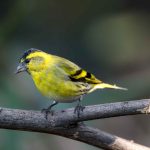

The pesticides currently in use are not much better – wiping out insects at an alarming rate.